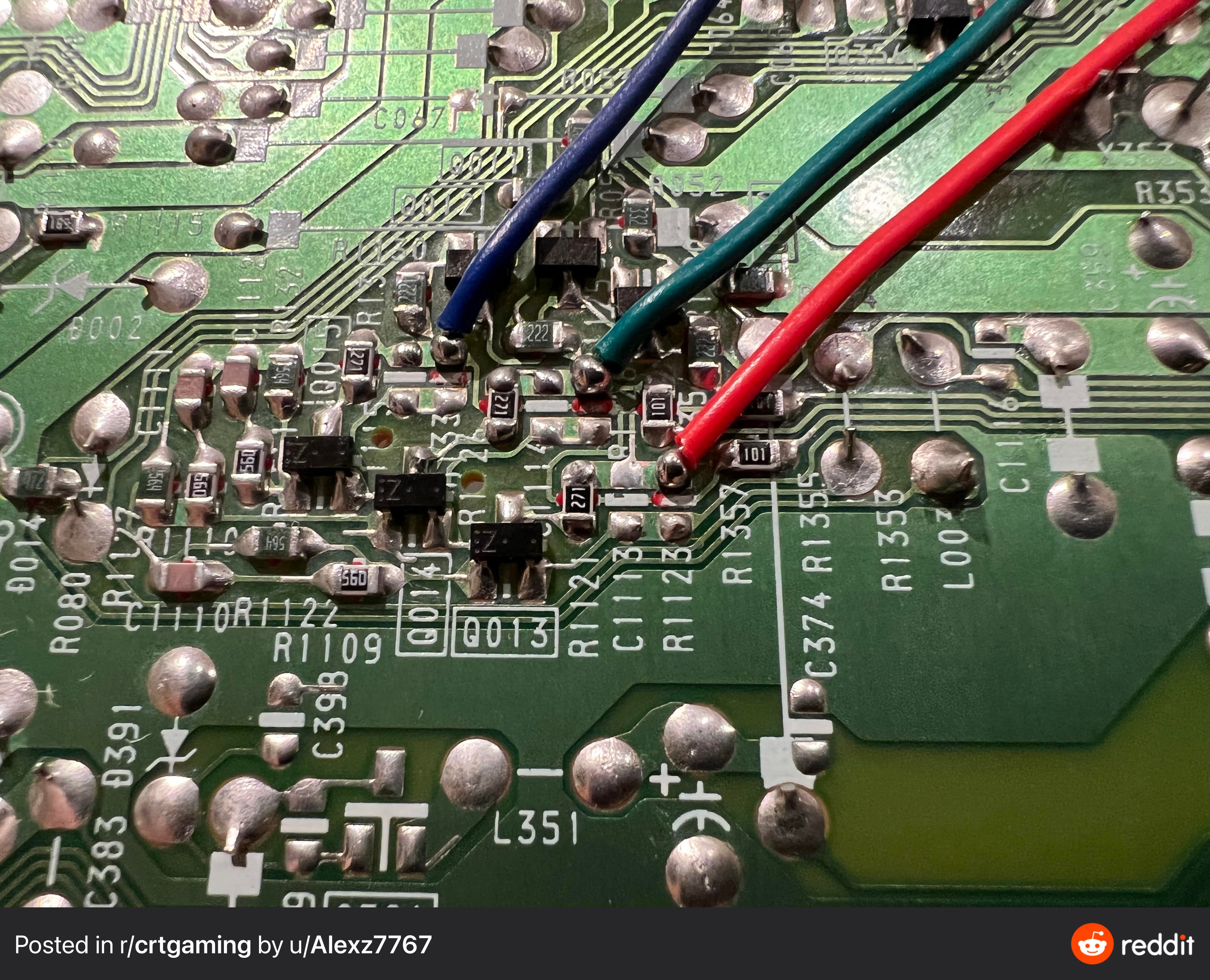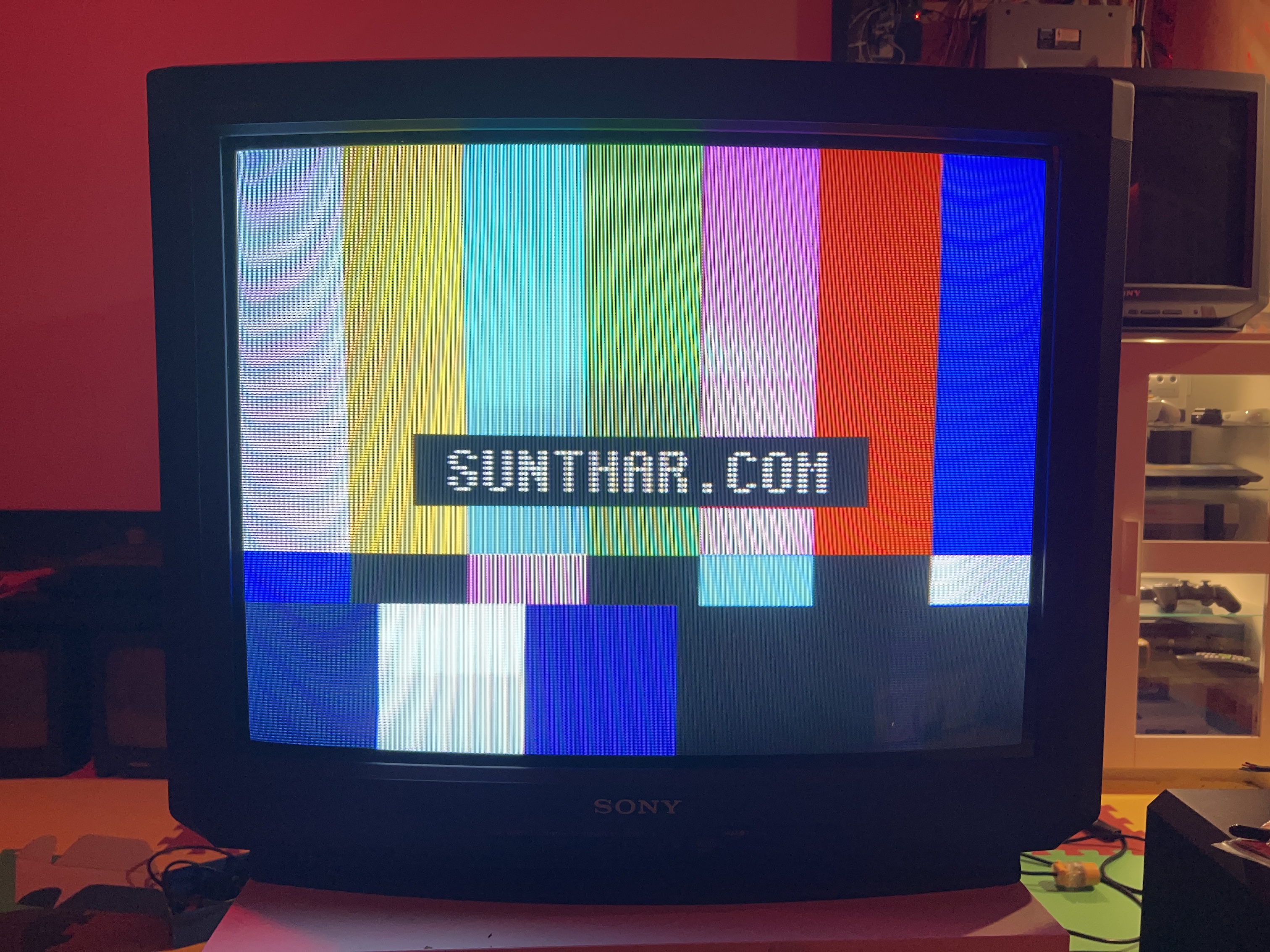
Sony KV (AA-2) 27V20
Sony AA-2 chassis CRT RGB mod
If you're looking to get the most out of your Sony Trinitron, you may want to consider modding it for RGB output. This guide will show you how to do just that.
Below mod was performed on a Sony KV-27V20 and Sony KV-27S22.
Sony KV-27V20 
CRT safety
Caution
You can die doing this! So read carefully! CRT TV is not a toy. Do not open a CRT TV. If you don't have any prior knowledge about handling high voltage devices, this guide is not for you. CRT TV contains high enough voltage (20,000+ V) and current to be deadly, even when it is turned off.
Plan of attack
Theory
Sometimes it is nice to know the theory behind the mod. I have put this on a separate page. This shows how the various resistor values are calculated.
Service manuals
- Sony KV-27V20 Service Manual
- Sony KV-27S20 Service Manual
- Sony KV-27V35 Service Manual
- Sony ID Codes - Needed for enabling S-Video
Specs (KV-27V20)
- Manufactured: March 1997, San Diego, USA
- NTSC, 60 Hz - 180W
- Chassis: AA-2
- OSD: CXP858-002 (IC001)
- Chroma: CXA2025 (IC351)
- Tube: Sony Trinitron A68KZJ50X


Schematics
Mux diagram
If you are building your own circuit, this diagram should help. The diagram is for KV-27V20, it will also work for other AA-2 chassis based Sony CRTs.

Step 1: Remove the following components
Remove R1123, R1128 and R133 
Inject R, G, B at the below locations R1123 (Red) R1128 (Green) R133 (Blue)

Step 2: Add a diode to blanking
Blanking diode added. Helps reduce interference. This mod was performed without shielded cables internally and absolutely no interference was noticed.

Step 3: Connect RGB and blanking wires
Refer to the image below for the precise soldering points for the red, green, blue, and blanking wires. For the R, G, and B wires, make sure not to solder to the pad connected to the ground.

Step 4: Connect audio, ground and sync wires
Now, it's time to turn our attention to the U board. In the image below, you can see where the audio, ground, and sync wires are connected. Since I'm using a separate cable for audio, the wire colors may not match the colors of the ribbon cable. Additionally, make sure to cut the trace as shown in the image.

- Red wire is audio right = grey wire on ribbon cable
- White wire is audio left = white wire on ribbon cable
- Black = black (common ground)
- Yellow = yellow (sync using luma input)
To enable the luma input, I chose to use a dummy S-Video plug. Essentially, this means simply plugging an S-Video cable into the S-Video port without connecting it to anything else. You can get creative with this setup—adding a switch to toggle luma on and off, permanently enabling luma, or even using a transistor to activate luma automatically when a SCART cable is connected using the 5V blanking signal. However, I opted for a straightforward and reliable solution with the dummy plug. This approach allows me to seamlessly use both S-Video and Composite input from the back panel whenever needed.

Step 5: Build your mux circuit
Below mod uses the RGB mux board. This is optional, but will make your mod easier and stable. You can also create the circuit presented in the schematics above without the board. Please also checkout the precalculated resistor values.
| TV Model | KV-27V20 | KV-27S22 |
|---|---|---|
| Add diodes to RGB lines (on chassis) | No | No |
| Add diode 1N4148 to blanking line (on chassis) | Yes | Yes |
| RGB termination (R1, R2, R3) | 75Ω | 75Ω |
| RGB inline resistors (R4, R5, R6) | 330Ω | 330Ω |
| Audio LR (R7, R8) | 1kΩ | 1kΩ |
| Diode (R9) | 1N4148 | 1N4148 |
| Blanking Ground Resistor (R10) optional | 330Ω | 330Ω |
| Blanking Resistor (R11) | 1kΩ | 1kΩ |
It is important to note that the blanking ground resistor (R10) is necessary to prevent strange black backgrounds from appearing on the KV-27S22 OSD text.
Picture of RGB mux rev B board 


Pictures
OSD mux overlay

One thing to note about the OSD overlay on top of the RGB image is that it appears sharp on darker screens, but on lighter screens, some streaking is noticeable. This issue only affects the OSD. By adjusting the inline resistors, I managed to reduce the streaking slightly, but I suspect the best solution might involve using diodes in the OSD path. However, this would add complexity to the mod without providing significant benefits. It's also possible that this issue is specific to this particular set.


Games & Pattern



Set

